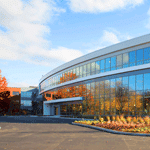This article is part of gb&d‘s Green Typologies series In the Workplace.
Most companies don’t have the opportunity to use their own products to construct their offices, but Schneider Electric is one of the exceptions. When the $30.8 billion Paris-based energy management company constructed a new global research and development center in Andover, Massachusetts, it populated the building with its building-technology products. Below, Bill Gause, executive vice president and partner of Leggat McCall Properties, the private real-estate company that worked with Schneider Electric on the buildout, shares the inner workings of making the client a part of the build.
gb&d: How did Leggat McCall become a part of this project?
Bill Gause: We acquired two foreclosed buildings from a lender in July 2010. One of them had tenants, but the other, which included about 160,000 square feet of space, was empty. As we went about the leasing process, we came into contact with Schneider Electric, which was looking to consolidate and relocate a number of its research and development operations in eastern Massachusetts into a new facility. The company settled on our building with the understanding that they’d be able to expand it by approximately 80,000 square feet to meet the needs of its growing workforce.
gb&d: Did Schneider Electric specify anything in particular for the project buildout?
Gause: Schneider Electric is at the forefront of the building-technology business and is focused on making energy safe, reliable, efficient, productive, and green. It is a global company that offers integrated solutions across multiple market segments, including non-residential building, utilities and infrastructure, industries and machines manufacturers, and data centers and networks to help its customers make the most of their energy. Over the past several years, Schneider Electric acquired several companies throughout Massachusetts and wanted to consolidate all of the companies’ business units and employees into one facility. With this consolidation, Schneider Electric is fostering more cross-discipline integration of its technology and creating a new, world-class research and development laboratory and a “StruxureLab,” where it tests and validates its solutions. The new building will reflect the company’s technological sophistication by incorporating its own energy-efficient products and solutions into the facility’s design, which will reduce energy use and operational costs in the long run.
gb&d: Did the client ask you to incorporate the use of those technologies in the new complex or was it something you chose to do as the building owner?
Gause: We built the core and shell of the new building, and Schneider Electric took over from there. Schneider Electric did use many of its own products in its buildout, including its SmartStruxure solution, which maximizes building efficiency and reduces operating costs by delivering integrated building information, real-time data from building systems, trend visualizations and other information that enables the company to effectively monitor, measure and optimize the building’s performance through its life cycle. With the SmartStruxure solution, the entire building, from heating and air-conditioning to security, will be controlled from a computer at one central location. The solution also facilitates the exchange and analysis of data from different building systems, including energy, lighting, and fire safety. The facility includes Square D by Schneider Electric electrical switchgear, Juno Lighting Group by Schneider Electric lighting fixtures, and several other Schneider Electric products and solutions.
gb&d: How did you incorporate sustainability into your portion of the project?
Gause: The building had to be designed in accordance with a relatively new stretch energy code mandated by Andover. That code requires a building to consume 20 percent less energy than a traditional building. So we looked at everything from the HVAC system to the glass load on the perimeter. We incorporated a chilled beam cooling system, which involves significantly higher up-front costs but substantially lower operating costs that lead to a payback over time. Materials, such as paints and carpets, are all low-VOC. All of the materials we used, from steel to gypsum, has a recycled component, and materials were sourced locally to the extent they were available locally. Daylighting—along with a design that places workstations on the perimeter—reduce the energy load from lighting. Occupancy sensors mitigate the extensive use of electricity when people aren’t present. There are also electric-car charging stations, another Schneider Electric product, at the site.
gb&d: What were some of the challenges you faced with this building? Gause: The site is relatively tight, shoehorned in between a number of wetlands, so we went through an extensive permitting process with the local conservation commission, and we were careful to make sure there was no impact on the surrounding wetlands. Otherwise it went smoothly, thanks in part to a collaborative effort between Leggat McCall Properties, Schneider Electric, and the design team at Perkins+Will. For example, we made a conscious decision to use Perkins+Will—which Schneider Electric was using for the fitting out of the interior—for our work on the base building. We felt that would minimize any conflicts.
This article is part of gb&d‘s Green Typologies series, which in each issue explores a single type of building. For more of our most recent collection, In the Workplace: Four Innovative Offices, choose from the list below:
- Power and Light: Nova Scotia Power Headquarters by WZMH Architects
- From Operating Rooms to Offices: CFA Institute offices
- Making Georgia Bloom: Super-Sod offices

